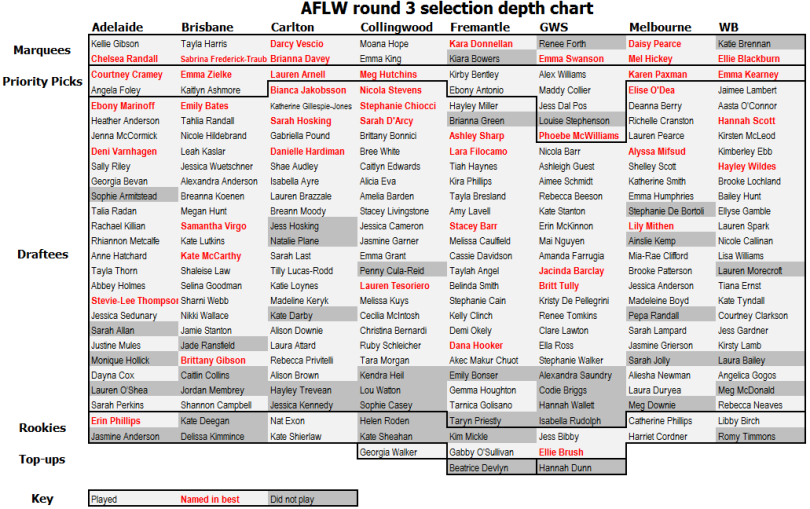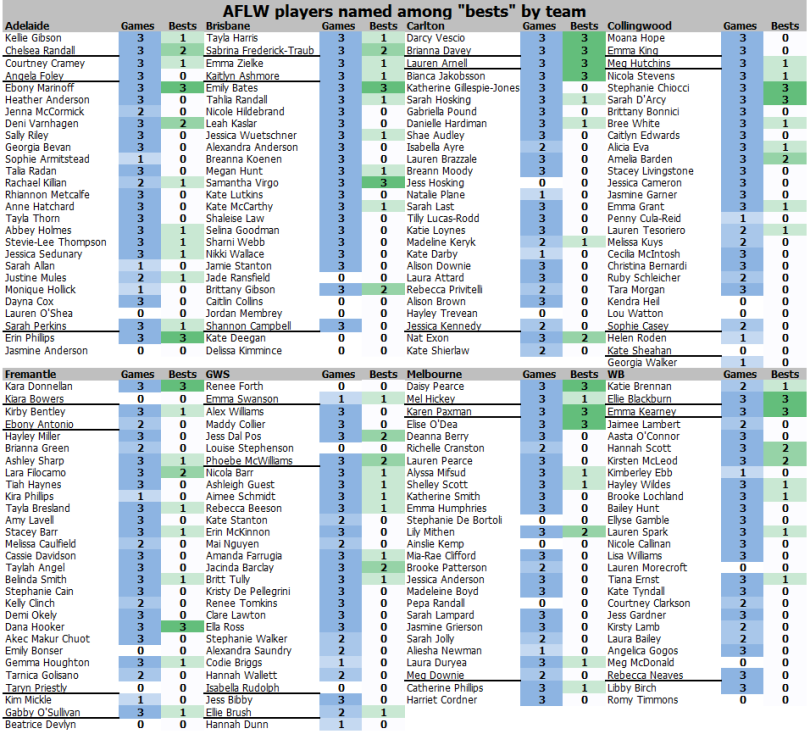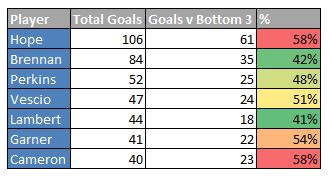Three weeks into the AFLW and our pre-season favourites Collingwood, a team highly fancied by many, sits last on the ladder wondering what has gone wrong. Before we dig into that, here’s a chart of the depth of each team that played on the weekend and who was among their best players:

Across most teams, this was a good week for their marquee and early draft picks who may be beginning to rose to the top.
We can flesh this picture out by showing who, across the first three weeks, has been among each team’s bests:

This is a chart of each clubs players, sorted by their selection by each club, with the number of games played and times included in the best players (as determined by afl.com.au). Whilst we disagree with some of the subjective calls made, it’s a good quick-and-dirty guide to where the contributions to each team have come through the first three rounds.
You can see that the bottom three teams on the ladder (Pies, Giants and Dockers) have had the least contribution from their top four players in terms of times named in the “bests”, although perhaps Emma King is a bit harshly done by on that front. At the other end of the scale, Carlton and Melbourne have had massive contributions from their marquee and priority picks, as well as their early draft selections. Adelaide show the edge with the biggest contribution from their bottom tier of players, with Phillips and Perkins providing a lot of value above expectation as rookie and free agent pickups.
HPN’s AFLW Power Rankings – Round Four
After our rough attempts to predict the finishing order way back in November, we’ve decided to open ourselves up to more embarrassment and combine our weekly wrap up with a power rankings of the teams through three weeks. HPN has waited this long because, as Figuring Footy pointed out last week, round three is where comparisons can truly commence.
This is a subjective ranking, but one informed by different data points we have looked at. For purely statistically based rankings of AFLW, HPN suggests looking at the fantastic work of James Day and FMI.
1. Adelaide
While you can mount a case for Brisbane at number one, the standout side so far has pretty clearly been Adelaide. Despite a scare last week against Carlton, the Crows have operated with surgical precision up forward and in the midfield. We’ve already written about their strong recruiting approach, but what is perhaps more impressive is their ability to work as a unit considering their lack of experience playing (or even training) together.
The Crows have placed a serious emphasis on moving the ball by foot, with the highest kick-to-handball ratio of the AFLW. Whereas other clubs try to work the ball around a little more, the Crows seem to look for distance whenever possible, to find their gun targets in an open forward line. It is pure, simple footy, like a hammer to the forebrain.
2. Brisbane
It turns out that cohesion has mattered to Brisbane, with the Queensland state squad (plus a couple of extras) fitting together like parts in a well-oiled machine. The Lions are clear league leaders for forward efficiency. They have had the fewest disposals in the competition, the second fewest hitouts and centre clearances. This has translated into the lowest amount of inside-50s in the competition, but they’ve managed to capitalise when the ball does go forward.
Tayla Harris has lead from the front so far, and leads the league with nine contested marks – four ahead of Jakobsson in second. Whilst Harris and Frederick-Traub are the focal points of the Lions attack, it is perhaps the most well-balanced in the competition to date, with four multiple goal kickers (no other club has more than three).
3. Melbourne
Melbourne took a while to get going, with their first 10 quarters together as a team (including the preseason game) achieving just three goals. Since then, however, they have been a comparative offensive juggernaut, kicking 12.9 across their last six quarters. This puts the Dees on pace as the most potent attacking side in the league, but the Small Sample Size light is flashing furiously just for the moment. Melbourne happen to lead the league in inside-50s, but until halftime in the Collingwood game they looked totally unable to capitalise on it.
The Dees also caught a break last week with Katie Brennan missing for the Dogs. Whilst Brennan might not have clawed back the 14 point difference on her own, playing a team without their leading goal-kicker is a good spot to land in.
This week the Demons are similarly lucky, facing a Carlton defence with the dominant Davey and Sarah Last. Whilst Carlton recorded an easy win in their preseason match, most of the damage was done in the final term, and Davey is a massive loss. If the Dees play their cards right, they could be coming into form at the right time.
4. Carlton
As mentioned above, Carlton face a challenging two weeks without Brianna Davey, and with Sarah Last to miss the rest of the year. This means that the Blues will be understrength in the backline, at a time when they face two relatively strong attacks (Melbourne and the Dogs).
Fourth might be a harsh rating for a side that has only lost one game, and that one by only three points to the ladder leaders. It is true that Carlton seem to do everything pretty well, leading the league in disposal efficiency, equal first in goals, equal second in marks, second in hitouts and third in tackles.
Like the Demons, the Blues have leant heavily on their elite talent, and so far they’ve responded strongly. Looking at the table above, the Blues’ first four picks have nearly monopolised the “bests” lists with all of Davey, Vescio, Arnell and Jakobsson featuring all three times. This concentration may suggest a bit of a vulnerability if those elite players are curbed. If Vescio gets double teamed, for instance, and without the strength of Davey down back, Carlton’s second tier could be tested.
The Blues defence has been a strong point so far, holding the otherwise free flowing Crows to just two goals last week, one of which booted from 55m out. If Carlton can get through the next two weeks (Melbourne and the Bulldogs) with two wins, they will firmly remain in contention for the Grand Final. In that case, the Lions matchup in round 7 potentially decides their fate.
5. Western Bulldogs
The Bulldogs have played some of the best football of the season, but have had significant flat spots as well. Blackburn and Kearney have been stellar through the middle, and Brennan (as mentioned elsewhere in this article) is as deadly up forward as anyone in the competition. The loss to Melbourne last week, however, makes it very hard for the Bulldogs to make the Grand Final.
In the short season to date, the Dogs have been the most inaccurate in front of goals, kicking 12.19. They’re also last in the competition in tackles, and for marks. Compared with the rest of the competition, the Dogs employ a much heavier emphasis on moving the ball by hand, averaging 18 more per game than the average team. They also sit second for running bounces.
This week they face the Pies, who they accounted for in their preseason match. If they can get a win this week, they will keep their small hopes of finals alive.
6. Fremantle
Fremantle have been a little disappointing to those at HPN Central so far, but perhaps some of that was misplaced expectation. The Dockers lost a lot of elite talent through the marquee and draft process, including some of the standouts of the AFLW to date. Donnellan is the one marquee that the Dockers were able to field this year, and her form has been outstanding to date, nearly dragging the Dockers over the line last week in Blacktown. Chuot, whilst not named in the best for any week, has been a strong rebounding presence so far, both repelling the opposition and setting up counter-attacks.
Looking through Fremantle’s statistics, the main conclusion to draw is that they just can’t score. They’re fairly middling (3rd to 6th) on most midfield stats and for inside-50s, but have displayed little ability to convert opportunities. They should have comfortably beaten the Giants with 13 scoring shots to 8 but of course they drew due to kicking 6.7 to 7.1. One clue may be their league-leading running bounces – is this an attacking tactic or aimlessness in the absence of targets?
This week they host the unbeaten Crows; a side they beat in their Darwin pre-season practice match fairly comfortably. As Greg Jericho pointed out on Twitter, the Crows were missing Phillips, but the differences in each team’s performance to date have been stark.
prob with pre-season, eg Philips for Crows didn't play, & 1 player can make more of a diff I reckon than in the men's comp
— Greg Jericho (@GrogsGamut) February 8, 2017
It will be interesting to see which one is the anomaly.
7. Collingwood
If the Crows have been the surprise packets so far, then the Pies have been the biggest disappointment of the young competition. A lot of that blame has fallen on the shoulders of Moana Hope, including accusations of being a “flat-track bully”. Most specifically, an article in The Age stated that Hope had kicked just four of her 106 goals against ladder leaders Darebin, which is accurate in isolation but devoid of any contextual information, such as that Darebin only conceded 61 goals in the regular season, period.
Yes, Hope kicked a majority of her goals (61 goals) against the bottom three sides, but this was a competition with a sixfold difference between the 439 points conceded by Darebin and the 2453 points conceded by Knox. The bottom three teams, Knox, Cranbourne and Geelong, conceded almost as many points as the top seven. Nearly every leading goal-kicker in the VFL last year had a similar goal feast against those three weaker opponents:

Hope is being double- and triple-teamed almost at every turn – and as a lead-up forward she is being given little room in which to work, and she isn’t as tall as some of the better contested-marking forwards in the league. In this situation, you would expect that the rest of the Collingwood forward line, including top VFL goal kickers Garner and Cameron to step up and provide alternative targets given the space that they have inherently been given. The Pies may also consider a second ruck in Lou Wotton to provide another target if they feel that’s an issue.
Girls Play Footy have excellently outlined all the issues that Collingwood face right now, and that Hope’s lack of production isn’t really one of them. GPF have rightly identified that Collingwood’s midfield hasn’t been providing a great quality or quantity of forward opportunities to date, with Sarah D’Arcy providing perhaps a sole shining light moving the ball forward. Collingwood have a league low three (3) goal assists through three rounds, which shouldn’t be the case with a dominant leading forward like Hope.
Things look a bit bleak for the Pies right now, but there’s a lot of footy left in the season to go.
8. GWS
GWS have looked better and better each week, and last week’s draw was a great result for a club that most (including HPN) thought would struggle to rise off the bottom of the ladder. Emma Swanson, in her first game for the club, made a real difference for the club on the ground, and the performance of Emma McKinnon in the ruck so far has been revelatory.
As the season has progressed some of GWS’s local talent has stepped up in intensity, and their results reflect this. The way they’ve gelled together and spread their workload has been quite impressive. As in the “bests” table above, no Giant has finished in the best for all three games; indicating a relatively well rounded roster, perhaps just short on truly elite talent (with apologies to Dal Pos, McWilliams and now Swanson).
This week they travel to Brisbane to face a red-hot Lions side who beat them in the pre-season in a dire, rain-sodden game. The Giants should circle their away trip to play Collingwood and their home game against the Dogs at Manuka as real opportunities to strike for their first win.
